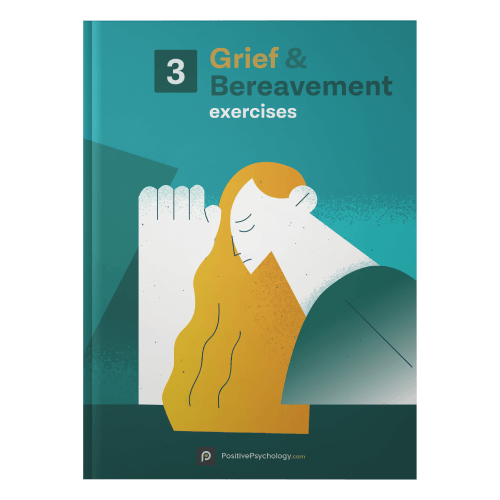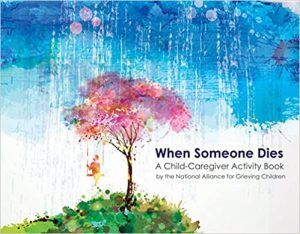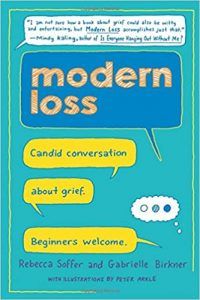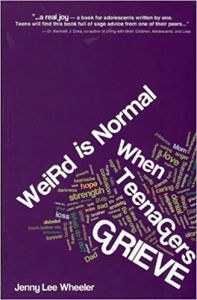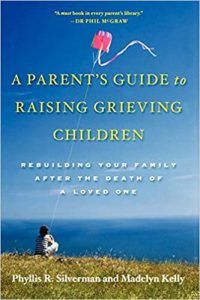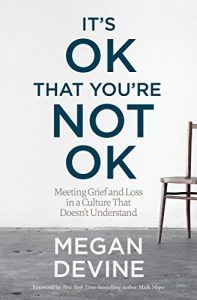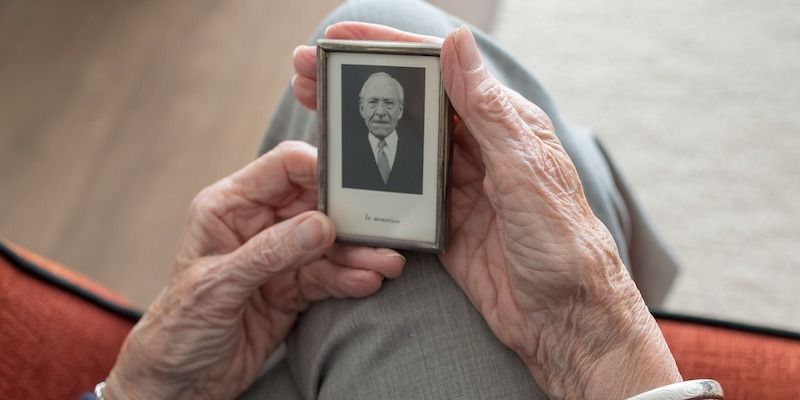Helping Kids Cope With Grief: 6+ Tips to Support Children
 Losing a loved one is never easy.
Losing a loved one is never easy.
For children, losing someone they love can be even more difficult because they are not only trying to process the loss themselves, but are also watching other loved ones grieve.
If children are very young when they lose a loved one, they may also experience the loss many times over as they go into adulthood and experience milestones without the person.
This article will provide a few ideas on how to explain grief to children, as well as recommendations for books and coping strategies to help deal with losing a loved one.
Before you continue reading, we thought you might like to download our three Grief Exercises [PDF] for free. These science-based tools will help you move yourself or others through grief in a compassionate way.
This Article Contains:
How Does Grief Affect Children?
Just as grief affects different people in different ways, grief affects children very differently than adults.
Even though adults are experiencing grief, they may be able to put on a ‘face’ to talk to others or get through the everyday tasks that are still required. Children might put on a similar ‘face,’ as they may go from being upset and crying in one moment to playing or engaging with others the next.
Younger children (babies, toddlers, and preschoolers) often struggle to understand what death is. They may go through some regressions (e.g., wetting the bed or having accidents after potty training) or become more clingy or anxious after someone they love has died.
In contrast, older children (teenagers) might experience waves or bursts of grief that come on suddenly. They might also start to withdraw from daily activities and lose interest in things that they might have previously enjoyed.
Even though it may be frustrating, it is important to be patient with children as they go through the grieving process. Grief does not have a specific timeline, and children may not want to deal with their feelings at the same time that adults do.
Providing children of all ages with patience, stability, and understanding is the first step in ensuring they have an environment where they can express their grief when they are ready to do so.
Explaining Grief Emotions to Children: 4 Tips

Strategies to implement when talking to children about a loss include:
- Encourage the child to ask questions.
Even though it may be upsetting, be open to answering any questions about death or the deceased individual. Especially if children are younger, they may struggle to understand the concept of death. - Spend one-to-one time with the child.
Ensuring that the child feels valued and prioritized is especially important. Even though a lot is going on and family members may have more responsibilities because of the loss, spending a few minutes playing or interacting with the child will go a long way.
Ask what games they want to play or if they want to do a specific activity together. Planning a game night or having a movie day can also help children feel like the time spent together is valuable, despite having recently experienced a loss.
- Use appropriate and accurate language.
Be specific and not vague about what happened to the person who passed away. For example, if children ask what ‘being dead’ is, use age-appropriate references to explain what it means (e.g., their body has stopped working; they cannot talk, move, breathe, or eat).
Helping Kids Cope With Grief and Loss
Dealing with grief and loss can cause a great deal of upheaval, for children and the surrounding adults. Because of the upheaval, children can sometimes act out or internalize their emotions in an effort to stop the pain they are feeling.
One of the most important things to do is to keep their routine consistent. Often, a loss can temporarily cause daily and weekly activities to be interrupted or derailed because of the funerary obligations that the adults have to meet after a death.
Even if it is difficult, ensure some aspects of their usual routine are met, such as attending extracurricular activities or playing with friends, so that children are reassured that things are still stable.
Another vital component of helping children develop coping skills to assist with grief is through developing an emotional vocabulary. Helping children develop an emotional vocabulary will help them name and describe different feelings.
Parents and teachers can foster children’s emotional vocabulary by teaching different feeling words and definitions directly or incidentally in the context of conversation (Joseph & Strain, 2003). It is important to show children that emotions are more than just being happy, sad, or mad and help them understand that there are different, more complex variations of these emotions.
If children are struggling to express their emotions verbally, encourage them to use a combination of the strategies below to express their emotions:
- Draw:
Encourage children to draw a picture of their memories of the individual who was lost. - Create:
Create a scrapbook or memory book with pictures of the deceased individual so that the child can have a special creation to look back on when they are feeling sad. - Write:
Give the child a journal so they can write about their thoughts and feelings. Encourage the child to write poems or stories if they show a particular passion for writing.
Giving a child several outlets to express their feelings is key in allowing them to work through the grieving process. In the Resources section below, we will share a few helpful worksheets.
6 Grief Books to Support Their Healing Process
To help caregivers, this section has resources that are focused on dealing with the emotions surrounding grief, as well as books that help explore the specific experience of loss and death.
There are also resources specific to the teenage experience, as teenagers tend to understand much more than younger children and may have more trouble dealing with the reaction from their peers and the interruption it causes to their daily life.
Last, this section also shares resources catered to self-care for parents and caregivers.
Books for children
1. When Someone Dies: A Child-Caregiver Activity Book – National Alliance for Grieving Children
Structured as an activity book for children to complete alongside their caregivers, this book provides several interactive activities that children can complete to better understand and help cope with their grief.
Activities focus on getting children to reflect on what life is like for them currently in everyday contexts (i.e., school and at home) and provide activities alongside these framing exercises to help in the formation of their identity.
Exercises like these can help children maintain a stable self-concept while they are dealing with the grief of losing a loved one.
Caregivers can also work through these exercises alongside the child to get a sense of what they are feeling and how they are dealing with different aspects of their life.
The book also helps to normalize different aspects of the memorial and funeral service that children may not be familiar with, which allows them to become more comfortable with something that might be otherwise quite intimidating.
Find the book on Amazon.
2. The Goodbye Book – Todd Parr
Although this book is not specific to grief, it provides a clear and approachable story about saying goodbye.
Parr documents the journey of saying goodbye through showing pictures of a goldfish who has lost its companion.
The book has illustrations of the fish going through various emotions and feelings upon losing someone, making it relatable and easy for children to identify the things they might be experiencing.
It is good for helping children between the ages of three to seven when they are having trouble developing an emotional vocabulary.
Find the book on Amazon. Here is a live reading of the book by Todd Parr.
Books for teenagers
1. Modern Loss: Candid Conversation About Grief. Beginners Welcome – Rebecca Soffer and Gabrielle Birkner
This book aims to reframe the emotions an individual feels when they are experiencing grief. The authors both lost parents when they were young and are aiming to bring more transparency when talking about grieving and dying.
The prevailing attitude of the authors is to minimize the stigma around grief and make death an accessible topic, since it is something that everyone will experience at some point.
This book is good for teenagers because it allows their experiences with grief to be normalized, instead of hidden for fear of embarrassment or feeling singled out.
Find the book on Amazon. The authors also have a website with further contributions about grief and loss.
2. Weird Is Normal When Teenagers Grieve – Jenny Lee Wheeler
This book is also written by an individual who lost a parent as a teenager. Wheeler aims to help reassure teenagers that the range of emotions they experience while grieving the loss of a loved one is completely normal and that teen grief is often overlooked.
Through sharing her own story, Wheeler provides coping strategies for teenagers at the end of each chapter, giving teenagers strategies to deal with their grief.
In addition, Wheeler also provides reassurance throughout the book that certain things that occur as a result of grief are okay (e.g., not having friends that understand, having ‘grief attacks’).
This book is great for teenagers and parents alike, as it helps them understand the unique form their grief might take and how it may differ from other adults around them.
Find the book on Amazon.
Books for parents and caregivers
1. A Parent’s Guide to Raising Grieving Children: Rebuilding Your Family After the Death of a Loved One – Phyllis Silverman and Madelyn Kelly
This guidebook is specifically for parents and provides strategies for dealing with all stages of the grieving process, including explaining death to children and teenagers and seeking out support groups to help during all stages of the grieving process.
Silverman and Kelly emphasize the importance of involving children throughout the grieving process and being upfront with them about the difficulties they are facing, in an age-appropriate manner.
The book is helpful for parents who are looking for guidance on addressing these topics candidly, as it can be very difficult to know how to bring up the topic of grief and loss to children.
Find the book on Amazon.
2. It’s OK That You’re Not OK: Meeting Grief and Loss in a Culture That Doesn’t Understand – Megan Devine
Devine writes from the perspective of a therapist and an individual who lost her partner in an accident.
She aims to provide readers with a new perspective on grief, stating that people experiencing grief should rebuild their life alongside it, rather than trying to overcome it completely.
The notion of accepting grief and building a new path is coupled with psychological interventions, including mindfulness-based practices and strategies to help decrease anxiety around rebuilding.
Although the book is not specific to parents helping grieving children, it is a good book for parents to read to have a coping strategy in combating their own grief. Upon accepting their own grief, parents can model how to live alongside their grief so that their children and teenagers can potentially adopt the same behaviors.
Find the book on Amazon.
Helpful Resources From PositivePsychology.com
PositivePsychology.com has several resources to help therapists and educators with the grieving process.
Our Realizing Resilience Masterclass aims to help practitioners and individuals deal with life’s challenges in a more resilient way. The masterclass aims to help participants learn the six pillars of resilience and understand how to overcome life’s obstacles.
Our Positive Psychology Toolkit© also has several resources to help individuals deal with grief. For example, The Life Certificate exercise aims to help individuals who have suffered a loss reflect on the positive aspects of the deceased, as well as add memories to the Life Certificate.
This could be a great exercise for children and parents to complete together, as they would be able to reflect on memories together and create a beautiful memento to look back on when they are upset.
The My Gravestone exercise helps individuals consider their own mortality while reflecting on the personal values that define them.
Even though this is not an exercise that is exclusively for people who are experiencing grief, it would be helpful for people who have recently suffered a loss to reconsider their personal values so they can keep living authentically.
For kids learning to cope with loss, these worksheets on identifying their feelings and dealing with emotions can be extremely helpful, providing space to address their emotions productively.
If you’re looking for more science-based ways to help others move through grief in a compassionate way, this collection contains 17 validated grief and bereavement exercises. Use them to help others find balance as they attempt to make sense of a life that has been irrevocably changed.
A Take-Home Message
Grief is an emotion that we all experience at some point in our lives. Whether it is the loss of a parent, relative, friend, or beloved pet, dealing with grief is an experience that requires a great deal of patience and, sometimes, takes more time to heal.
Similar to the instructions on an airplane to put on your own mask first if the plane is losing oxygen, you need to ensure your mask is securely fastened before helping children and other passengers who need assistance.
It is important to take care of yourself and deal with grief alongside or even before helping others.
When dealing with children, let them work through their grief in their own way. Keep in mind they may not be ready to talk about it right away, but continue to be supportive and leave the door open for them to share their feelings in whatever way feels right to them.
Be patient when dealing with grief, and remember, you are never alone.
We hope you enjoyed reading this article. Don’t forget to download our three Grief Exercises [PDF] for free.
- Devine, M. (2017). It’s OK that you’re not OK: Meeting grief and loss in a culture that doesn’t understand. Sounds True.
- Joseph, G. E., & Strain, P. S. (2003). Enhancing emotional vocabulary in young children. The Center on the Emotional Foundations for Early Learning. Retrieved on April 26, 2021, from http://csefel.vanderbilt.edu/modules/module2/handout6.pdf
- National Alliance for Grieving Children. (2016). When someone dies: A child-caregiver activity book. National Alliance for Grieving Children.
- Parr, T. (2015). The goodbye book. Little Brown Books for Young Readers.
- Silverman, P. R., & Kelly, M. (2009). A parent’s guide to raising grieving children: Rebuilding your family after the death of a loved one. Oxford University Press.
- Soffer, R., & Birkner, G. (2018). Modern loss: Candid conversations about grief. Beginners welcome. Harper Wave.
- Wheeler, J. L. (2010). Weird is normal when teenagers grieve. Quality of Life.
Read other articles by their category
- Body & Brain (49)
- Coaching & Application (57)
- Compassion (26)
- Counseling (51)
- Emotional Intelligence (24)
- Gratitude (18)
- Grief & Bereavement (21)
- Happiness & SWB (40)
- Meaning & Values (26)
- Meditation (20)
- Mindfulness (45)
- Motivation & Goals (45)
- Optimism & Mindset (34)
- Positive CBT (28)
- Positive Communication (20)
- Positive Education (47)
- Positive Emotions (32)
- Positive Leadership (18)
- Positive Parenting (4)
- Positive Psychology (33)
- Positive Workplace (37)
- Productivity (16)
- Relationships (46)
- Resilience & Coping (36)
- Self Awareness (21)
- Self Esteem (37)
- Strengths & Virtues (31)
- Stress & Burnout Prevention (34)
- Theory & Books (46)
- Therapy Exercises (37)
- Types of Therapy (64)
